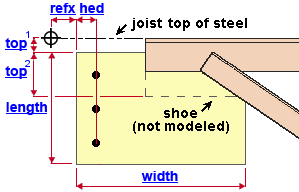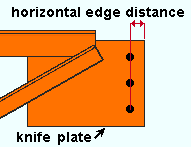"  Knife Plate " connection design locks
Knife Plate " connection design locks
- Joists with flush framed connections do not have shoes. Joists with bearing or seated connections do have shoes. Vulcraft CJ series joists are typically used with the ' Flush framed shear ' and ' Flush framed clip ' connection types. However, using a CJ series joist as your " Section size " is not a requirement.
|
|||||
"  |
|
||||
|
|||||
User Defined Connections: Settings that are locked (
) in a user defined connection file will automatically be locked on a Joist Edit window for which that file is the " User defined connection ." You can, if you so choose, manually lock additional settings on the member edit window, and your changes will be retained, through multiple processes, so long as you do not change to a different connection then switch back to the original user defined connection.
Joist Edit: To change a setting, first set it to locked (
). Related settings that are unlocked (
) may be updated, and the "
Left/Right end limit state " calculations will be updated. Settings that are locked (
) will not be changed by connection design , even if doing so might prevent a connection failure.
Connection design locks (also see the drawing ) :
![]() Knife Plate
Knife Plate
Top of plate ( top ): The positive (+) or negative (-) distance from the joist reference line to the top edge of the knife plate. In the above example , the reference line is at the top of steel, and this distance is positive.
Plate length ( length ): The distance (parallel with the depth of the joist) between the two edges of the knife plate that are parallel with the reference line of the joist (see example ). For a non-sloping joist, this distance is vertical. For a sloping joist, this distance is perpendicular to the work line of the joist (parallel with the depth of the joist).
End connection failure message: Locked dimension is less than minimum allowed
Plate width ( width ): The distance (parallel with the reference line of the joist) between the edges of the knife plate that are perpendicular to the joist (see example ). For a non-sloping joist, this distance is horizontal.
Plate thickness: The " Material thickness " of the knife plate.

Home > Project Settings > Fabricator > Standard Fabricator Connections > Joist Connection Settings > " Knife plate thickness " sets the thickness that connection design uses when this lockable field is unlocked (
).
Refx: The distance (parallel with the reference line of the joist) from the work point of the joist to the edge of the knife plate that is closest to that work point (see example ). This distance is horizontal only if the joist is horizontal.
Horizontal edge distance ( hed ): The distance (parallel with the reference line of the joist) from the framing edge of the joist's knife plate to the center of the nearest column of holes. A knife plate can have two columns of holes when, in "
Connection specifications " for a flush-framed shear plate, the option to "
Try two bolt column shear tabs " is checked. For a flush-framed clip angle, the knife plate may have two columns of holes when the clip angle " Gage " is ' Wide '.

Home > Project Settings > Fabricator > Standard Fabricator Connections > Joist Connection Settings > " Knife plate horizontal edge distance " sets the default edge distance that connection design uses when this lockable field is unlocked (
).







